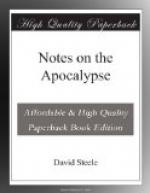Verse 1.—The dividing of the books of Scripture into chapters and verses is not by inspiration. Fallible men have used their discretion in this respect, as they still do, by parceling chapters into sections, paragraphs, &c. And so, although we have passed to another chapter, the vision is the same. The inspired penman had looked upon the great King surrounded by part of his retinue. In earnest expectation of farther discoveries, he beheld “in the right hand of him that sat on the throne a book written within and on the back side,” (or outside, as in some copies.) The book was “sealed with seven seals.” This volume was in the form of a roll, as the word volume signifies. The form of a book is determined by the kind of material on which one writes. This has consisted of great variety in the successive ages of the world. The first of which we have any notice in history is stone. When Job, in his affliction, was sustained by faith in the promised Redeemer; and when he would emphasize and transmit an expression of that faith to future generations; he thought of the nearest expedient familiar to his mind:—“Oh that my words were now written.... that they were graven with an iron pen.... in the rock forever,” (Job xix. 23, 24.) On the same material the law was written at Horeb, (Exod. xxiv. 12.) No doubt this was the usual method of recording events in Egypt in the time of Joseph, as the word “hieroglyphics” or sacred sculpture, appears to imply. Next, it appears that the inside bark of trees was used for this purpose, as of birch, which has a natural tendency to curl or roll together when dry. Hence the word library, and volume, or rolled bark. The royal archives, or “house of the rolls,” is thus explained, (Ezra. vi. 1.) “Vellum,” or dressed skins of beasts, appears to have been next used; then linen and cotton; and as now put through a chemical process, these are the material in most common use at the present day. Thus contemplating the symbol in the text, we may trace in our thoughts the gradual advancement of this department of science and the mechanic arts. The second stage of progress had been reached in John’s time, from stone to the bark of timber. The “book” appears to have been of cylindrical form, but whether in one piece or in seven separate pieces, revolving on a common axis, it is not easy nor perhaps important to determine. It is of much greater importance to know that the “book” is emblematical of the decrees of God. This will appear by comparing Psalm xl. 7, where we find the same symbol employed to represent the record of covenant agreement or stipulation between the Father and the Son, and to which our Saviour appeals as evidence in his case. (Heb. x. 7.) While the symbol may be safely considered as involving all the purposes of God; it signifies here more especially the following part of the Apocalypse, containing, as it were, a transcript from the great original.—“Seals”




